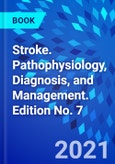- Helps you recognize the clinical manifestations of stroke, use the latest laboratory and imaging studies to arrive at a diagnosis, and generate an effective medical and surgical treatment plan.
- Keeps you abreast of the overwhelming volume of studies and guidelines in this dynamic field, providing clear summaries and practical evaluations of all relevant data.
- Contains updates throughout, including the latest clinical trials (thrombectomy, DAWN, DEFUSE), genetics research, prevention research, new therapies, and the new guidelines from the ASA.
- Includes new slides for lectures, covering basic science, case studies, and interventional treatment overviews.
- Features a Key Points summary at the beginning of each chapter so you can quickly find important information.
- Provides abundant full-color CT images and pathology slides that help you make efficient and accurate diagnoses.
- Enhanced eBook version included with purchase. Your enhanced eBook allows you to access all of the text, figures, and references from the book on a variety of devices.
Table of Contents
Section 1 Pathophysiology
Introduction
1. Cerebral Vascular Biology in Health and Disease
2. Mechanisms of Thrombosis and Thrombolysis
3. Cerebral Blood Flow and Metabolism: Regulation and Pathophysiology in Cerebrovascular Disease
4. Histopathology of Brain Tissue Response to Stroke and Injury
5. Molecular and Cellular Mechanisms of Ischemia-Induced Neuronal Death
6. Intracellular Signaling: Mediators and Protective Responses
7. The Neurovascular Unit and Responses to Ischemia
8. Mechanisms of Damage After Cerebral Hemorrhage
9. White Matter Pathophysiology
10. Cerebral Ischemia and Inflammation
11. Mechanisms of Plasticity, Remodeling and Recovery
12. Genetics and Vascular Biology of Brain Vascular Malformations
13. Gliovascular Mechanisms and White Matter Injury in Vascular Cognitive Impairment and Dementia
Section 2 Epidemiology and Risk Factors
Introduction
14. Global Burden of Stroke
15. Stroke Disparities
16. Risk Factors and Prevention
17. Prognosis after Stroke
18. Vascular Dementia and Cognitive Impairment
19. Genetic Basis of Stroke Occurrence, Prevention and Outcome
Section 3 Clinical Manifestations
Introduction
20. Classification of Ischemic Stroke
21. Clinical Scales to Assess Patients with Stroke
22. Carotid Artery Disease
23. Anterior Cerebral Artery Disease
24. Middle Cerebral Artery Disease
25. Posterior Cerebral Artery Disease
26. Vertebrobasilar Disease
27. Lacunar Syndromes, Lacunar Infarcts, and Cerebral Small-Vessel Disease
28. Intracerebral Hemorrhage
29. Aneurysmal Subarachnoid Hemorrhage
30. Arteriovenous Malformations and Other Vascular Anomalies
31. Stroke and Other Vascular Syndromes of the Spinal Cord
Section 4 Specific Conditions and Stroke
Introduction
32. Cardiac Diseases
33. Atherosclerotic Disease of the Proximal Aorta
34. Stroke Related to Surgery and Other Procedures
35. Arterial Dissection, Fibromuscular Dysplasia, and Carotid Web
36. Inflammatory and Infectious Vasculopathies
37. Reversible Cerebral Vasoconstriction Syndromes
38. Posterior Reversible Encephalopathy Syndrome
39. Stroke and Substance Abuse
40. Moyamoya Disease
41. Cerebral Autosomal Dominant Arteriopathy with Subcortical Infarcts and Leukoencephalopathy
42. Hematologic Disorders and Stroke
43. Migraine and Stroke
44. Cryptogenic Stroke
45. Cerebral Venous Thrombosis
Section 5 Diagnostic Studies
Introduction
46. Ultrasonography
47. Computed Tomography-Based Evaluation of Cerebrovascular Disease
48. Magnetic Resonance Imaging of Cerebrovascular Diseases
49. Cerebral Angiography
50. OMICs in Stroke: Insight into stroke through epigenomics, transcriptomics, proteomics, lipidomics, and metabolomics
Section 6 Therapy
Part A: Medical Therapy
Introduction
51. Stroke Systems of Care and Impact on Acute Stroke Treatment
52. Prehospital and Emergency Department Care of the Patient with Acute Stroke
53. Intravenous Thrombolysis
54. Antithrombotic Therapy for Treatment of Acute Ischemic Stroke
55. General Stroke Management and Stroke Units
56. Critical Care of the Patient with Acute Stroke,
57. Pharmacologic Modification of Acute Cerebral Ischemia
58. Treatment of "Other" Stroke Etiologies
59. Medical Therapy of Intracerebral and Intraventricular Hemorrhage
60. Rehabilitation and Recovery of the Patient with Stroke
61. Interventions to Improve Recovery after Stroke
62. Enhancing Stroke Recovery with Cellular Therapies
63. Antiplatelet Therapy for Secondary Prevention of Stroke
64. Secondary Prevention of Cardioembolic Stroke
65. Design of Stroke-Related Clinical Trials
Part B: Interventional Therapy
Introduction
66. Endovascular Therapy of Extracranial and Intracranial Occlusive Disease
67. Endovascular Treatment of Acute Ischemic Stroke
68. Endovascular Treatment of Intracranial Aneurysms
69. Interventional Therapy of Brain and Spinal Arteriovenous Malformations
70. Dural Arteriovenous Malformations
Part C: Surgical Therapy
Introduction
71. Surgery of Anterior and Posterior Aneurysms
72. Surgery for Intracerebral Hemorrhage
73. Management of Intraventricular Hemorrhage
74. Surgical Management of Cranial and Spinal Arteriovenous Malformations
75. Surgical Management of Cavernous Malformations and Venous Anomalies
76. Indications for Carotid Endarterectomy in Patients with Asymptomatic and Symptomatic Carotid Stenosis
77. Extracranial to Intracranial Bypass for Cerebral Ischemia
78. Decompressive Craniectomy for Infarction and Hemorrhage








